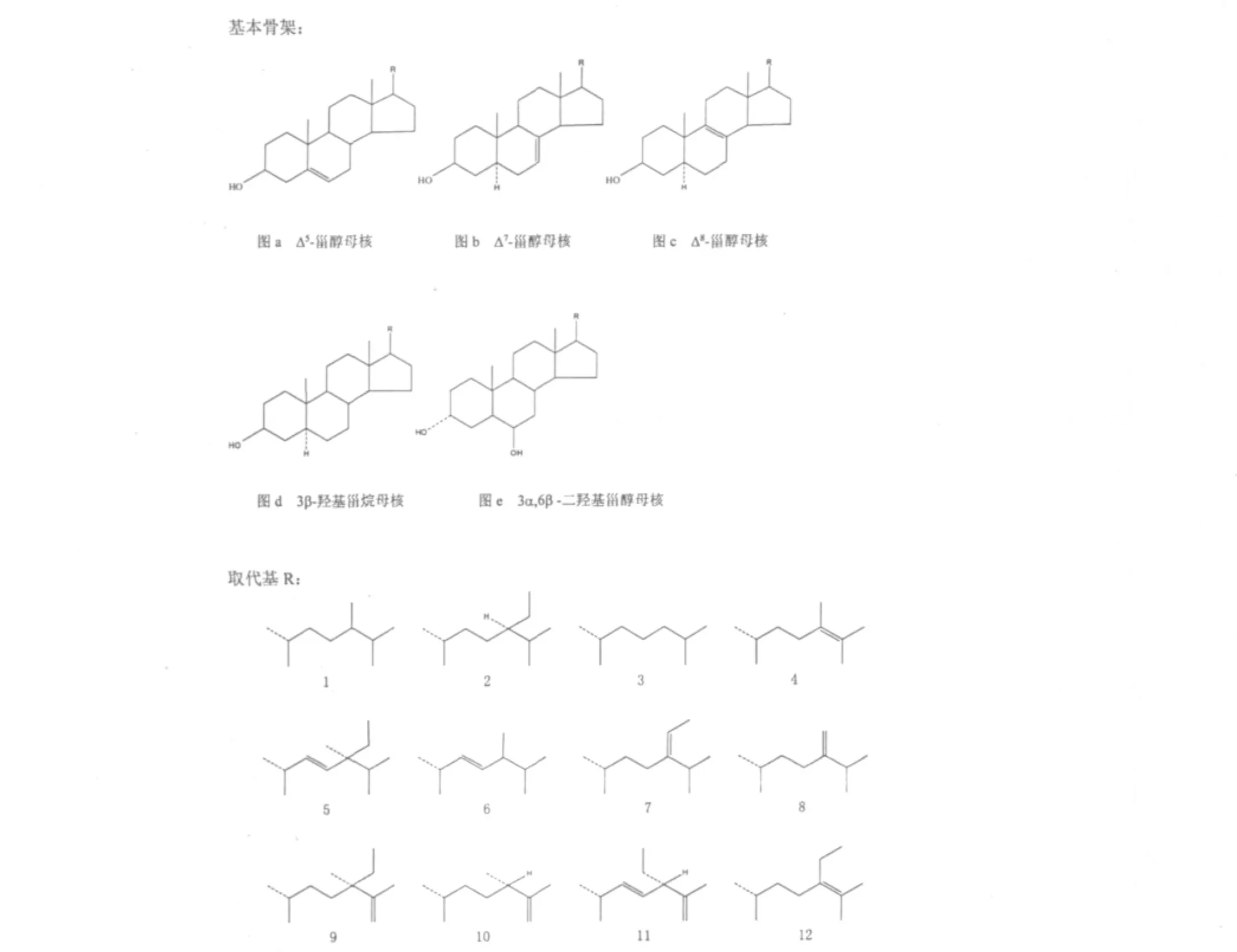葫芦科药用植物甾醇类成分研究进展
2012-09-12吴晓毅巢志茂刘海萍谭志高
吴晓毅,巢志茂,刘海萍,王 淳,谭志高,孙 文
中国中医科学院中药研究所,北京 100700
葫芦科植物资源丰富,全世界共有约113属800种,我国有32属154种35变种,主要分布于西南部和南部,少数散布到北部[1]。我国能纳入药用植物的有20属43种,可作113味药材[2]。我国葫芦科大多数的药用植物既可药用,又可食用,例如,卫生部2002年监发的[2002]51号文《关于进一步规范保健食品原料管理的通知》中明确规定:罗汉果既是食品又是药品,绞股蓝则可作为保健食品使用。葫芦科药用植物化学成分复杂多样,常见的有植物甾醇类、脂肪酸类、三萜类、糖和苷类、氨基酸类及挥发性成分等。国内外学者对其化学成分的研究比较广泛和深入,聂瑞麟曾对1980-1992年葫芦科植物三萜皂苷的研究进展进行了归纳总结[3],邱明华等对葫芦科的化学分类学进行了研究[4],Akihisa等学者对葫芦科常见12个属的植物甾醇类成分进行了报道[5],朱靖静等对2004-2009年葫芦科中主要的葫芦素类四环三萜化合物进行了概括总结[6],但葫芦科药用植物中植物甾醇类成分的研究尚未见系统的报道。本综述对近三十多年来我国葫芦科药用植物中植物甾醇的化学结构、特征1H NMR数据和药理活性进行了系统的归纳和总结。
植物甾醇在植物界分布广泛,多与油脂类成分共存于植物的种子和花粉中,具有和胆固醇相似的化学结构,可降低血液中的胆固醇含量,在市场上广泛应用于功能性食品。我国卫生部2010年发布的第3号公告,批准了植物甾醇及其酯可作为新资源食品。植物甾醇的广泛应用,受到了学者们的关注,王会等对植物甾醇的应用与研发进行了简单的总结[7],韩军花等对我国30种药食两用植物和40种中草药原料中植物甾醇的含量进行了研究分析[8]。本文根据国内外近30年来的研究报道,对我国葫芦科药用植物中的植物甾醇成分进行了归纳总结,为葫芦科药用植物资源的开发利用提供参考依据。
1 常见葫芦科药用植物中植物甾醇的结构和植物来源
我国葫芦科常见的药用植物中,黄瓜、栝楼、冬瓜、苦瓜、绞股蓝等13种植物的果实和种子均有较高含量的植物甾醇,少数植物甾醇分布在地上部分[5]。迄今为止,在葫芦科药用植物中,文献共报道了29个植物甾醇类化合物。植物甾醇名称与所属植物来源见表1。

表1 植物甾醇结构与来源Table 1 Chemical structures and sources of phytosterols in Cucurbitaceae plants

备注:冬瓜 Benincasa hispida(Thunb.)Cogn.、西瓜 Citullus lanatus(Thunb.)、甜瓜 Cucumis melo L.、黄瓜 Cucumis sativus L.、南瓜 Cucurbita moschata(Duch.ex Lam.)Duch.ex Poir.、红南瓜 Cucurbita pepo L.var.kintoga Makino、绞股蓝 Gymnopetalum pentaphyllum(Thunb.)Makino、葫芦 Lagenaria siceraria(Molina)Standl.、丝瓜 Luffa cylindricall(L.)Roem、苦瓜 Momordica charantia L.、木鳖 Momordica cochinchinensis(Lour.)Spreng、王瓜 Trichosanthes cucumeroides(Ser.)Maxim.、栝楼 Trichosanthes kirillowii Maxim.
化学结构如下所示: 基本骨架:

植物甾醇是在甾体母核C17位有8-10个碳原子链状侧链的甾体衍生物,一般分子中具有1~3个双键。通常根据甾醇母核中双键的个数和位置将其进行分类,常见的有△5-植物甾醇、△7-植物甾醇、△8-植物甾醇和无双键植物甾醇四大类,其中,△5、△7-植物甾醇较常见。在植物不同的生长时期,△5、△7植物甾醇的含量也会随之发生变化[23]。现将葫芦科药用植物中发现的29种植物甾醇的特征1H NMR数据予以列表,见表2。

表2 植物甾醇的特征1H NMR数据Table 2 Characteristic1H NMR spectral data of phytosterols

△7 22-二氢菠菜甾醇22-dihydrospinasterol 2b△7,22 菠菜甾醇spinasterol 5b△7,22 24-甲基胆甾-7,22-二烯醇24-methylcholesta-7,22-dienol 6b△7,24 燕麦甾醇avenasterol 7b△7,25 24-乙基胆甾-7,25-二烯醇24-ethylcholesta-7,25-dienol 9b△7,22,25 24-乙基胆甾-7,22,25-三烯醇24-ethylcholesta-7,22,25-trienol 11b△8 24-乙基胆甾-8(14)-烯醇24-ethylcholest-8(14)-enol 2c△8,22 24-乙基胆甾-8,22-二烯醇24-ethylcholesta-8,22-dienol 5c△8,25 24-乙基胆甾-8,25-二烯醇24-ethylcholesta-8,25-dienol 9c△8,22,2524-乙基胆甾-8,22,25(27)-三烯醇24-ethylcholesta-8,22,25(27)-trienol 11c 0.660(3H,s,18-H),0.990(3H,s,19-H),0.900(3H,d,J=6.3 HZ,21-H),0.810(3H,d,J=6.6 HZ,26-H),0.790(3H,d,J=6.6 HZ,27-H),0.820(3H,t,J=6.8 HZ,29-H),3.500(1H,m,3-H),5.330(1H,d,J=4.8 HZ,7-H)0.551(3H,s,18-H),0.800(3H,s,19-H),1.025(3H,d,J=6.5 HZ,21-H),5.027(1H,dd,J=ca7.5 HZ,22-H),5.163(1H,dd,J=ca7.5 HZ,23-H),0.799(3H,d,J=6.2 HZ,26-H),0.849(3H,d,J=6.2 HZ,27-H),0.820(3H,t,J=6.8 HZ,29-H)0.543(3H,s,18-H),0.813(3H,s,19-H),1.008(3H,d,J=6.5 HZ,21-H),0.839(3H,d,J=6.8 HZ,26-H),0.822(3H,d,J=6.8 HZ,27-H),0.912(3H,d,J=6.8 HZ,28-H)0.537(3H,s,18-H),0.795(3H,s,19-H),0.949(3H,d,J=6.5 HZ,21-H),2.830(1H,m,25-H),0.976(6H,dd,J=6.7 HZ,26-,27-H),5.106(1H,m,28-H),1.588(3H,d,J=6.5 HZ,29-H)0.526(3H,s,18-H),0.795(3H,s,19-H),0.909(3H,d,J=6.5 HZ,21-H),1.566(3H,s,26-H),4.692(2H,brs,27-H),0.800(3H,t,J=7.2 HZ,29-H),3.599(1H,m,3-H),5.159(1H,brs,7-H)0.545(3H,s,18-H),0.797(3H,s,19-H),1.019(3H,d,J=6.5 HZ,21-H),5.221(2H,m,22-,23-H),1.653(3H,s,26-H),4.705(2H,s,27-H),0.834(3H,t,J=7.3 HZ,29-H)3.599(1H,m,3-H),5.159(1H,brs,7-H)0.935(3H,d,J=6.4 HZ,21-H),0.836(3H,d,J=6.7 HZ,26-H),0.814(3H,d,J=6.7 HZ,27-H),0.843(3H,t,J=8.3 HZ,29-H),4.71(1H,m,3-H)0.621(3H,s,18-H),0.964(3H,s,19-H),1.032(3H,d,J=6.5 HZ,21-H),5.120(2H,m,22-,23-H),0.850(3H,d,J=6.8 HZ,26-H),0.801(3H,d,J=6.8 HZ,27-H),0.805(3H,t,J=6.7 HZ,29-H),4.74(1H,m,3-H)0.599(3H,s,18-H),0.959(3H,s,19-H),0.912(3H,d,J=6.5 HZ,21-H),1.562(3H,s,26-H),0.800(3H,t,J=6.7 HZ,29-H)0.617(3H,s,18-H),0.962(3H,s,19-H),1.020(3H,d,J=6.5 HZ,21-H),1.650(3H,s,26-H),4.697(2H,s,27-H),0.834(3H,d,J=7.3 HZ,29-H)10,18 10,18 18 10 10,18 10,18,19 5 5,18 18 18无双键 豆甾烷-3β,6α-二醇stigmastane-3β,6α-diol 2e 9 0.6503H,s,18-H),0.820(3H,s,19-H),0.910(3H,d,J=6.0 HZ,21-H),0.840(3H,d,J=7.2 HZ,26-H),0.810(3H,d,J=7.2 HZ,27-H),0.840(3H,t,J=7.7 HZ,29-H),3.580(1H,tt,J=11.0 HZ,5.1 HZ,3-H),3.420(1H,td,J=11.0 HZ,4.4 HZ,6-H)
2 药理作用
2.1 抑制胆固醇吸收,防治心脑血管疾病
植物甾醇具有和胆固醇相似的化学结构,在人体小肠中能够抑制胆固醇的吸收[24-26],降低血液中的胆固醇浓度,从而达到防治冠心病、动脉粥样硬化等疾病[27]。每天服用0.8~4.0g植物甾醇,就能将低密度脂蛋白的浓度水平降低10% ~15%[26],若患者的低密度脂蛋白浓度水平越高(被定义为大于等于3.5 mmol/L),植物甾醇的作用越明显[28-30]。当植物甾醇和燕麦-β-葡萄糖结合使用时,能增强其降低血浆胆固醇的水平[31]。2010年,我国卫生部发布第3号公告,批准植物甾醇及植物甾醇酯等7种物质作为新资源食品。
2.2 抗炎作用
豆甾醇对一些促炎因子有明显的抑制作用[32],而一些低热量、富含植物甾醇的橘汁饮料则能降低12%的炎症指标超敏C反应蛋白[33]。β-谷甾醇由于有类似于氢化可的松和羟基保泰松等的抗炎作用,还可直接入药,临床上由β-谷甾醇与其他药物组成的克平喘,有较强的平喘、止咳、祛痰的作用,能够促进慢性气管炎病变组织的修复[7]。
2.3 抗氧化作用
IsoPs是脂质过氧化产物,具有特殊的生物活性,能引起氧化应激性,因此,降低IsoPs的浓度,即可达到抗氧化的作用。Mannarin等学者研究得出,若连续六周服用富含植物甾醇的食品,血浆中的8-IsoPs浓度即随着血浆总胆固醇浓度和低密度脂蛋白胆固醇浓度的降低而显著下降[34]。此外,β-谷甾醇,豆甾醇和菜油甾醇还能有效地保护低密度脂蛋白的过氧化[36]。
2.4 抗癌作用
Awad等学者研究发现,植物甾醇可以显著减少胆酸引起的细胞增殖,降低细胞的有丝分裂,如:β-谷甾醇可降低胆汁酸和胆汁酸代谢物的浓度,并能抑制化学致癌剂诱发的肠癌。通过大量的临床试验,当总植物甾醇摄入量增加时,胃癌发病率下降,当和α胡萝卜素的摄入量共同增多时,胃癌的发生率下降得更为明显[36]。
2.5 防治前列腺疾病
Berges发现,β-谷甾醇培养可促进人类前列腺基质细胞生长因子β1的表达和增强蛋白激酶C-α的活性[37],VonHoltz 研究表明,用 β-谷甾醇来培养细胞可增加鞘磷脂循环中的两种关键酶——磷脂酶D和蛋白磷脂酶的活性,促进鞘磷脂循环,抑制细胞的生长,从而有效防止男性前列腺肥大[38]。
2.6 其他作用
植物甾醇对皮肤有较强的渗透性,能保持皮肤表面水份,促进皮肤新陈代谢,抑制皮肤炎症,可防止日晒红斑、皮肤老化,具有美容之功效,如:β-谷甾醇能使干燥和硬化的角质皮肤恢复柔软,防治皮肤晒伤,防止和抑制鸡眼的形成[7]。植物甾醇可与脂质在水中形成分子膜,促进动物性蛋白质的合成[7]。
3 结论与讨论
葫芦科植物既是重要的食用资源,又为人们提供了丰富的药用植物资源。植物甾醇作为葫芦科植物含有的主要成分,在工业、食品、化妆品等领域起着重要的作用。韩军花等学者估算我国植物甾醇的平均摄入量为每日 322.41 mg[39],但至今为止,对于葫芦科药用植物的研究,以及其中的植物甾醇类成分的研究还远远不够。本文对13种药用植物中的植物甾醇进行了归纳总结,仅占我国葫芦科药用植物总数的1/3,还有大量的植物尚未见相关的研究和报道,有待深入研究,以扩大葫芦科丰富的药用植物资源的开发和利用。
1 The Flora of China Commission in Chinese Academy of Science(中国科学院中国植物志编辑委员会).Flora of China(中国植物志).BEIJING:Scientific& Technical Publishers,2004,3:84.
2 The Chinese Materia Medica Commission(中华本草编委会).Chinese Materia Medica(中华本草)1999,5:502-595.
3 Nie RL(聂瑞麟).The decadal progress of triterpene saponins from Cucurbitaceae(1980-1992).ActaBotanica Yunnanica(云南植物研究),1994,16:201-208.
4 Qiu MH(邱明华),et al.Chemotaxonomy of Cucurbitaceae.Chin J Appl Environ Biol(应用与环境生物学报),2005,11(6):673-685.
5 Akihisa T,et al.Sterol compositions of seeds and mature plants of family Cucurbitaceae.Oil Chem Soc,1986,63:653-658.
6 Zhu JJ(朱靖静),Zou K(邹坤).Current research progress of Cucurbitacins.J Chin Three Gorges Univ,Nat Sci(三峡大学学报,自科版),2009,31(5):82-87.
7 Wang H(王会),Zhang PX(张普香).The application and development of phytosterols.Sci&Tech Info(科技资讯),2009,194(17):1-1.
8 Han JH(韩军花),et al.The phytosterols content in plant materials commonly used in functional food in China.Acta NutrSinica(营养学报),2010,32:82-85.
9 Chao ZM,et al.Some triterpenes and steroids from the seeds of Trichosanthes cucumeroides.Phytomedicines(Recent progress in Medicinal Plants)Studium Press LLC,2007,16:544-554.
10 Garg VK,Nes WR.Occurrence of△5-sterols in plants producing predominantly△7-sterols:studies on the sterol compositions of six Cucurbitaceae seeds.Phytochemistry,1986,25:2591-2597.
11 Chen DC(陈德昌).The13C NMR and Its Application in the Chemistry of Chinese Herbal Medicine(碳谱及其在中草药化学中的应用).BEIJING:People’s Medical Publishing House,1991.
12 GargVK,NesWR.Codisterol and other Δ5-sterols in the seeds of Cucurbita maxima.Phytochemistry,1984,23:2925-2929.
13 Grunwald C.Plant sterols.Ann Rev Plant Physiol,1975,26:209-236.
14 Itoh T,et al.Co-occurrence of chondrillasterol and spinasterol in two Cucurbitaceaeseeds as shown by13C NMR.Phytochemistry,1981,20:761-764.
15 Garg VK,NesWR.Studies on the C-24 configurations of Δ7-sterols in theseeds of Cucurbita maxima.Phytochemistry,1984,23:2919-2923.
16 Subramanian SS,et al.(24S)-Ethylcholesta-5,22,25-triene-3β-olfrom four Clerodendron species.Phytochemistry,1973,12:2078-2079.
17 Pinto WJ,Nes WR.24 Ethylsterols,n-alkanes and n-alkanols of Clerodendrum splendens.Phytochemistry,1985,24:1095-1097.
18 Akihisa T,et al.Sterols of Cucurbitaceae:the configuration at C-24 of 24-alkyl-△5,△7-and △8-sterols.Lipids,1986,21:39-47.
19 Ma TJ(马挺军),et al.Chemical constituents of Bolbostemma paniculatum.ActaBot Boreal-Occident Sin(西北植物学报),2005,25:1163-1165.
20 Wang SZ(王赛贞),et al.Isolation and characterization of cholesterol in gandoerma iucidum fruitbody.Acta Edulis Fungi(食用菌学报),2005,12(1):5-8.
21 Kuang YY(匡云艳),et al.A studyon chemicalconstituents of softcoralSinularia gyrosa.J Tropical Oceanography(热带海洋学报),2002,21(3):95-98.
22 Matsumoto T,et al.24α-Methyl-5α-cholest-7-en-3β-ol from seed oil of Helianthus annuus.Phytochemistry,1984,23:921-923.
23 Gara VK,Nes WR.Changes in Δ5-and Δ7-sterols during germination and seedling development of Cucurbita maxima during germination and seedling development of Cucurbita maxima.Lipids,1985,20:876-882.
24 Mttson FH,et al.Opyimizing the effect of plant sterols on cholesterol absorption in man.Am J Clin Nutr,1982,35:697-700.
25 Plat J,Mensink RP.Plant stanol and sterol esters in the control of blood cheolesterol levels:Mechanismand safety aspects.Am J Cardiol,2005,96:15-22.
26 Katan MB,et al.Efficacy and safety of plant stanols and sterols in the management of blood cholesterol levels.Mayo Clin Proc,2003,78:965-978.
27 Bañuls C,et al.Evaluation of cardiovascular risk and oxidative stress parametersin hypercholesterolemic subjects on a standard healthy diet including low-fat milk enriched with plantsterols.J NutrBiochem,2010,21:881-886.
28 Abumweis SS,et al.Plant sterols/stanols as cholesterol lowering agents:ameta-analysis of randomized controlled trials.FoodNutr Res,2008:52.
29 Demonty I,et al.Continuous dose-response relationship of the LDL-cholesterol-lowering effect of phytosterol intake.J Nutr,2009,139:271-284.
30 Seppo L,et al.Plant stanol esters in low-fat milk products lower serum total and LDL cholesterol.Eur J Nutr,2007,46:111-117.
31 Theuwissen E,et al.Consumption of oat beta-glucan with or without plant stanols did notinfluence inflammatory markers in hypercholesterolemic subjects.Mol Nutr Food Res,2009,53:370-376.
32 Gabay O,et al.Stigmasterol:a phytosterol with potential antiosteoarthritic properties.Osteoand Cartil,2010,18:106-116.
33 Devaraj S,et al.Reduced-calorie orange juice beverage with plant sterols lowers C-reactive protein concentrations and improves the lipid profile in human volunteers.Am J Clin Nutr,2006,84:756-761.
34 Mannarino E,et al.Effects of a phytosterol-enriched dairy product on lipids,sterols and 8-isoprostane in hypercholesterolernic patients:a multicenter Italian study.Nutr Metab Cardiovasc Dis,2009,19(2):84-90.
35 Ferretti G,et al.Effect of phytosterols on copper lipid peroxidation of human low-density lipoproteins.Nutrition,2010,26:296-304.
36 Awad AB,et al.Beta-sitosterol inhibits HT-29 human colon cancer cell growth and alters membrane lipids.Anticancer Res,1996,16:2797-2804.
37 Berges RR,et al.Treatment of symptomatic benign prostatic hyperplasia with beta-sitosterol:an 18-month follow-up.BJUInt.,2000,85:842-846.
38 Holtz RL,et al.β-Sitosterol activates the shpingomyelin cycle and induces apoptosis in LNCaP human prostate cancer cells.Nutr Cancer,1998,32:8-12.
39 Han JH(韩军花),et al.Analysis of phytosterol contents in Chinese plant food and primary estimation of its intake of people.J Hygiene Res(卫生研究),2007,36:301-305.
